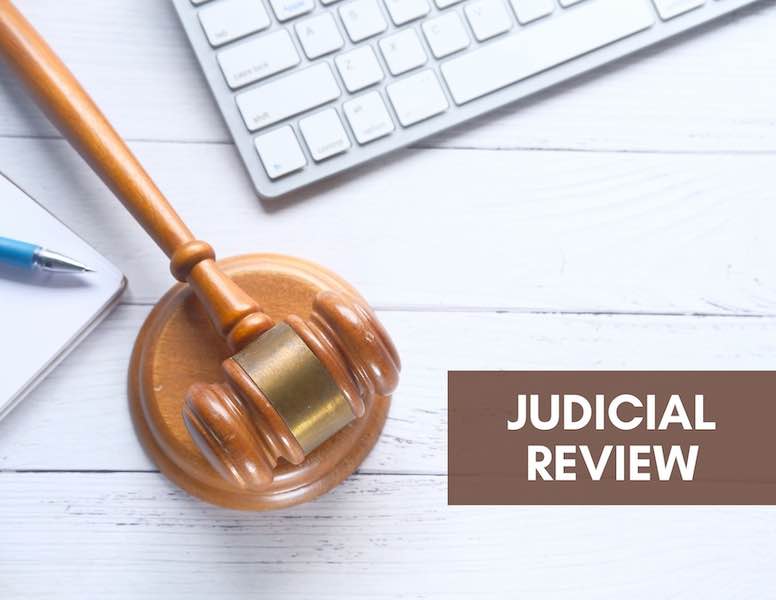Challenging Administrative Decisions – Ouster Clause to the Rescue
by Henn Xhen Low ~ 15 January 2021
The usual recourse for a party aggrieved of an administrative decision by a public authority is to challenge the said decision by way of a judicial review proceeding which has been provided under Order 53 of the Rules of Court 2012.
In order for an administrative decision to be judicially reviewed, Suriyadi FCJ when delivering judgment of the Federal Court in WRP Asia Pacific Sdn Bhd v Tenaga Nasional Bhd [2012] 4 MLJ 296 stated that:
“[9] An application for judicial review is a particular procedure by which an aggrieved person an seek to review a public authority’s decision, with judicial review referring to the power to supervise the activities, inclusive of the latter decision.
…
[12] … leave may be granted if the leave application is not thought as frivolous, and if leave is granted, an arguable case in favour of granting the relieve sought at the substantive hearing may be the resultant outcome… ”
Edgar Joseph Jr FCJ in R Rama Chandran v The Industrial Court of Malaysia & Anor [1997] 1 MLJ 145 stated the following when he discussed the grounds for judicial review:
“It is often said that Judicial Review is concerned not with the decision but the decision- making process. (See eg Chief Constable of North Wales Police v Evans [1982] 1 WLR 1155). This proposition, at full face value, may well convey the impression that the jurisdiction of the courts in Judicial Review proceedings is confined to cases where the aggrieved party has not received fair treat ment by the authority to which he has been subjected. Put differently, in
the words of Lord Diplock in Council of Civil Service Unions & Ors v Minister for the Civil Service [1985] AC 374 , where the impugned decision is flawed on the ground of procedural impropriety.
But Lord Diplock’s other grounds for impugning a decision susceptible to Judicial Review make it abundantly clear that such a decision is also open to challenge on grounds of ‘ illegality’ and ‘irrationality’ and, in practice, this permits the courts to scrutinize such decisions not only for process, but also for substance.
In this context, it is useful to note how Lord Diplock (at pp 410 –411) defined the three grounds of review, to wit, ( i) illegality, (ii) irrationality, and (iii) procedural impropriety. This is how he put it :
By ‘ illegality’ as a ground for Judicial Review I mean that the decision maker must understand directly the law that regulates his decision making power and must give effect to it …
By ‘irrationality’ I mean what can by now be succinctly referred to as ‘Wednesbury unreasonableness’ (see Associated Provincial Picture Houses Ltd v Wednesbury Corp [1948] 1 KB 223). It applies to a decision which is so outrageous in its defiance of logic or of accepted moral standards that no sensible person who had applied his mind to the question to be decided could have arrived at it … ‘ Irrationality’ by now can stand on its own feet as an accepted ground on which a decision may be attacked by Judicial Review.
I have described the third head as ‘ procedural impropriety’ rather than failure to observe basic rules of natural justice or failing to act with procedural fairness towards the person who will be affected by the decision. This is because susceptibility to Judicial Review under this head covers also failure by an administrative
tribunal to observe procedural rules t hat are expressly laid down in the legislative instrument by which its jurisdiction is conferred, even where such failure does not involve any denial of natural justice.
Lord Diplock also mentioned ‘proportionality’ as a possible fourth ground of review which called for development.”
As a result, judicial review against administrative decisions can generally be performed not only on the ground of procedural non-compliance but also on the grounds of illegality, irrationality and possibly proportionality.
However, more often than not, administrative decisions by public authorities exercising their power vested by statutory legislation are protected by a provision under the same legislation known to be the ouster clause.
Ouster Clause and Its Spectrum
An ouster clause serves as a mechanism to prevent certain administrative decisions from being reviewed by the court of law through, inter alia, a judicial review proceeding.
Zawawi Salleh JCA in the case of Ambiga a/ p Sreenevasan v Director of Immigration, Sabah, Noor Alam Khan bin A Wahid Khan & Ors [2018] 1 MLJ 633 explained that:
“[18] Broadly speaking, ouster clauses are legislative provisions that purport to prevent certain administrative decision from being subject to judicial review. Such clauses thus serve as a signal to decision – makers that they may operate without fear and intervention by the courts at a later stage. One common kind of ouster clause is the total ouster or finality clause, which is inserted into a statute to indicate that the decision of a particular tribunal or authority is final
and cannot be challenged in any court (see Mark Aronson & Bruce Dyer, Judicial Review of Administrative Actions (2nd Ed, 20 00 at p 678). ”
An example of a total ouster clause of finality clause is section 59A of the Immigration Act 1959/63 (“Act 155 ”). Section 59A of Act 155 before its amendment, read as follows:
“An order of the Minister or the Director General under this act or any subsidiary legislation made under this act shall (without prejudice to any provision giving a right to appeal to the Minister in respect of an order of the Director General) be final and shall not be called in question in any court on any ground whatsoever.”
The old section 59A was then replaced with a new one which came into force on 01.02.1997 which read as follow:
“59A. (1) There shall be no judicial review in any court of any act done or any decision made by the Minister or the Director General, or in the case of an East Malaysian State, the State Authority, under this Act except in regard to any question relating to compliance with any procedural requirement of this Act or the regulations governing that act or decision.
(2) In this section, “judicial review” includes proceedings instituted by way of-
an application for any of the prerogative orders of mandamus, prohibition and certiorari;
an application for a declaration or an injunction; (c) any writ of habeas corpus; or
(d) any other suit or action relating to or arising out of any act done or any decision made in pursuance of any power conferred upon the Minister or the Director General, or in the case of an East
Malaysian State, the State Authority, by any provisions of this Act.”
Section 59A of Act 155 functioned as a preventive mechanism to exclude the decisions of the Minister or the Director-General of the Sabah and Sarawak State Authority from being judicially reviewed except for any procedural non-compliance.
Application of this provision has been illustrated in the Federal Court case of Pihak Berkuasa Negeri Sabah v Sugumar Balakrishnan [2002] 3 MLJ 72 where Dzaiddin FCJ stated that:
“… the language in the present s 59A is explicit with respect to the exclusion of the judicial review by any court of any act or decision made by the minister, director general or the state authority under the Act except for non-compliance of any procedural requirement … By deliberately spelling out there shall be no judicial review by the court of any act or decision of the minister or the decision maker except for non-compliance of any procedural requirement, Parliament must have intended that the section is conclusive on the exclusion of judicial review under the Act .”
The extent of the scope of such ouster clause would sometimes infringe even the fundamental liberties of a person enshrined under the Federal Constitution (“FC ”).
The Court of Appeal in Ambiga a/ p Sreenevasan having referred to the case of Sugumar stated the following:
“[23] … the constitutional rights under art 5 (1) of the Federal Constitution can be removed in accordance with law as constitutional rights are not absolute. It was held that the effect of the ouster clause was clearly intended by the Parliament to remove judicial review. Thus, the right to justice cannot be sustained in the face of an express statutory ouster of judicial review. ”
In a Nutshell
Even though ouster clauses assist public authorities in making certain decisions without fear, these clauses at the same time impede the aggrieved parties’ access to justice by preventing said decisions from being judicially reviewed.
Ouster clauses such as section 59A of Act 155 have a wide range of applicability to the extent that they unreasonably infringe the fundamental liberties enshrined within the FC.
There have been advocates for the Parliament to do away with ouster clause due to its unconstitutionality. However, unless and until legislation is passed to declare all ouster clauses as unconstitutional, these clauses will always be a threat to the rule of law and the jurisdiction of the judicial system in our nation.

